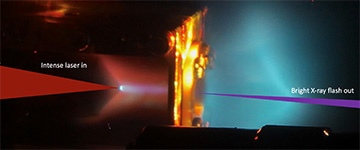![]()
Researchers at the Gemini Laser Facility, Central Laser Facility, U.K. The laser was used to drive the creation, through laser wakefield acceleration, of X-rays that can potentially be used to probe processes in solid matter at extremely high temperatures, relevant to fusion energy and studies of planetary interiors. [Image: STFC]
The dynamics of high-energy density (HED) matter—“warm, dense matter,” with the density of a solid but at temperatures as high as 10,000 °C—hold potential insights in domains ranging from studies of planetary interiors to efforts for fusion energy. But getting a grip on those ephemeral, femtosecond-scale processes in these piping-hot materials has been tough.
An international team led by researchers at Imperial College London (ICL), U.K., now reports that it has developed a practical platform for study of these ultrafast HED-matter processes (Phys. Rev. Lett., doi: 10.1103/PhysRevLett.123.254801). The secret lies in tricking out a laser-wakefield accelerator (LWFA) to deliver single-shot, broadband X-ray fluxes that are reportedly 100 times greater than previous measurements—and that pack enough energy to get the job done.
Difficult environment for study
In principle, researchers interested in atomic-scale dynamics in HED matter have a number of options for peering into the maelstrom. But none are perfect. X-ray scattering, for example, reportedly falls short for studying non-equilibrium processes, and the extremely small scattering cross-sections require hefty, high-brightness sources such as X-ray free-electron lasers (XFELs) to get any meaningful result.
A potentially better and more flexible route to studying HED-matter processes is X-ray absorption, which overcomes some of the experimental limitations of scattering techniques. But performing single-shot experiments that could capture the ultrafast dynamics at work requires a combination—high-brightness, broadband X-rays with multi-keV photon energy—that been elusive in practice. Behemoth lasers like the U.S. National Ignition Facility, for example, can supply plenty of photon energy, but in pulses on the scale a hundred picoseconds or even longer. Synchrotron sources also lack ultrashort duration, while XFEL pulses, though short enough, lack the required broadband operation.
Realizing the LWFA advantage
LWFAs, which use laser-driven plasmas to accelerate electrons and create by-product X-rays through betatron radiation, could potentially circumvent these problems. That’s because LWFAs are, according to the researchers behind the new study, “the only currently available sources that provide bright bursts of broadband X-rays on the femtosecond timescale.”
But heretofore, the source fluxes and photon energies available in LWFAs have required integration across many shots to achieve the energy needed to study warm dense matter. Getting a true, femtosecond-scale view of electron dynamics in HED matter would require an LWFA that could pack sufficient energy into a single, ultrafast broadband pulse.
In the setup for generating ultrashort X-ray bursts, the driving laser passes through a gas cell (left), accelerating electrons and creating a plasma wakefield that gives rise to high-energy X-rays that exit through a pinhole (right). [Image: Brendan Kettle] [Enlarge image]
The ICL-led team, helmed by Stuart Mangles and by first author Brendan Kettle, sought to achieve just that, with a novel setup. The setup begins with an extremely powerful driving laser, the 200-TW Gemini Laser at the U.K.’s Central Laser Facility at Rutherford Appleton Laboratory. The laser’s 800-nm-wavelength beam is focused into a helium gas cell, where it strips electrons from the gas and creates an electron plasma wave in the laser’s wake. The high laser fields subsequently accelerate the electrons to GeV-scale energies, forcing out high-energy betatron X-rays. A sacrificial length of polyimide plastic tape absorbs the surplus laser energy and allows the X-rays to pass through to the sample.
In measurements with their setup, the researchers found that the use of the powerful Gemini Laser to drive an LWFA allowed the creation of single shots with energies in the 5-keV range, and with photon flxes on the order of 1.2 million per eV. The team was able to use those pulses to perform X-ray absorption near-edge structure experiments on a piece of room-temperature titanium foil. And numerical simulations by the team suggest that it should work as a platform for ultrafast electron processes in HED matter as well.
Higher-intensity lasers ahead
The team believes that such experiments will become increasingly viable as new and even higher-intensity driving lasers (such as those at the European Extreme Light Infrastructure) come online. The researchers envision setups in which these LWFA-driving lasers are deployed in tandem with XFELs or other high-energy lasers that are used to push the samples to HED states, which are then probed with the LWFA-generated X-rays in ultrafast and brilliant single shots.
“We will now be able to probe warm dense matter much more efficiently, and in unprecedented resolution,” first author Kettle said in an ICL press release accompanying the work. That, he suggested, “could accelerate discoveries in fusion experiments and astrophysics, such as the internal structure and evolution of planets including the Earth itself.”

